American partners have more demands
Sharing with the business community of Ho Chi Minh City in the talkshow about the 20% reciprocal tax, its impact and solutions for businesses, Dr. Can Van Luc said that although the US side announced the reciprocal tax from April 2, exports until the end of June were not affected, and businesses also took advantage of the opportunity to speed up shipments before the official tax rate was issued. However, from this July, the effects have begun to appear.
Mr. Luc said that some businesses shared with him that American partners are very cautious in placing orders, and if they do have orders, they also limit the quantity they buy.
Mr. Nguyen Manh Hung, Vice Chairman of the Board of Directors - CEO of Nafoods Group also confirmed that exporting to the US market has started to be more difficult and slower. Nafoods Group exports to 70 markets but the proportion of goods sold to the US is quite high, accounting for 22% including fresh fruit and processed fruit.

According to Dr. Can Van Luc, ministries and branches continue to negotiate to bring the corresponding tax rate below 20%.
“During the waiting period from mid-July until now, American buyers have been placing orders very cautiously and the purchase volume has decreased significantly. They are negotiating with us to share the 20% tax. But the negotiations are also taking place slowly because both sides are cautious,” said Mr. Hung.
This businessman believes that if the agricultural export tax is increased from 0% to 20%, and is passed on to customers, and consumers have to bear it, they will not accept it immediately. So businesses have to share, which will reduce profit margins, or even make no profit. But what is more difficult is that partners are slow to buy and cautious in placing orders. Businesses have to accept inventory, making it difficult to turn around cash flow.
“If the tax rate for agricultural products is fixed at 20%, we can still accept it if there are many other supporting policies such as interest rate compensation for export loans, more administrative procedures, more support for production, preservation, transportation conditions, etc.
What I am concerned about is the long-term disadvantage for farmers. Fresh American fruit imported into Vietnam is currently more expensive than fresh Vietnamese fruit exported to the US. If the import tax is 0%, there will be a lot of pressure on both Vietnamese farmers and businesses, because domestic costs will increase. American fruit is cheap, domestic fruit will find it harder to compete, ” Mr. Hung added.
Similarly, the textile and garment industry has also seen exports slow down since July. According to Mr. Pham Van Viet, Chairman of Viet Thang Jean Company Limited, textile and garment exports to the US market since July have been very slow.
Currently, the orders to the US that the company produces until June 20th are all shipped in time before the expected tax date. New orders with new designs and new orders will continue to be made. For normal, basic goods, the tax rate must be reviewed. It is expected that the US market will increase again in September.
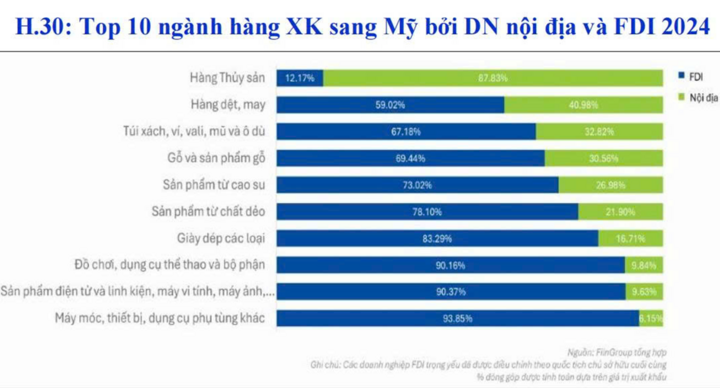
Top 10 export industries to the US market, of which the seafood industry has 87.83% of Vietnamese enterprises participating in direct exports. (Source: BIDV Institute for International Trade)
Refreshing the old market
According to Mr. Viet, although July exports decreased, in the first 7 months of the year, the entire textile and garment industry still grew and is trying to achieve double-digit growth.
“The advantage is that the end of the year is a shopping season. Moreover, the Vietnamese textile and garment industry has exported to 107 countries and territories. To reduce dependence on the US market, we are shifting to exporting more to the EU, which is a more stable and sustainable market. For Viet Thang Jean in particular, the US market previously accounted for about 30%, but since the beginning of the year, we have been pushing into the EU, South Korea and many new markets and selling domestically," said Mr. Viet.
In addition, another advantage that Mr. Viet believes that textile and garment enterprises in particular and exporters in general benefit from in the current conditions is that Vietnam has signed 17 free trade agreements (FTAs). Markets such as Korea, Japan, and the EU have quite good import volume.
“There are some businesses whose US market still accounts for 70-80%, but we have proactively shared orders from other markets. We have determined not to focus on any one market in the current volatile situation,” Mr. Viet added.
In the agricultural sector, according to Chairman of Phuc Sinh Group Phan Minh Thong, Vietnam is exporting a large number of products to the US such as seafood, coffee, pepper, and cashews. Particularly, pepper is also exported to the US in the largest quantity.
Compared to Thailand and the Philippines with the same tax rate of 19% and Vietnam's largest competitive market, Brazil with a tax rate of 50%, Vietnam still has a chance. However, he said that associations, industries, and partners continue to negotiate, hoping to bring the tax rate to 0% for products that the US cannot produce such as pepper, cinnamon, and star anise.
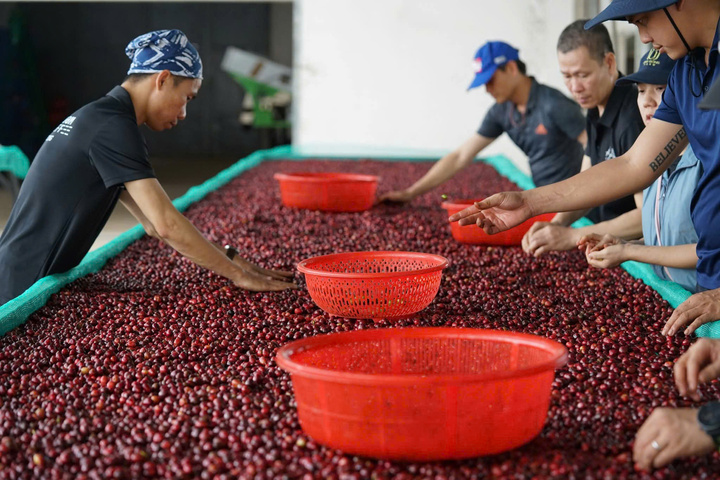
Vietnam exports large amounts of pepper, coffee, and cashews to the US market every year.
Regarding the wood industry, Chairman of the Handicraft and Wood Processing Association of Ho Chi Minh City (HAWA) Phung Quoc Man said that businesses are "no longer shocked". The results of negotiations between the US and other countries competing in the industry with Vietnam for many years have not been much different, still at 19-20%.
But the Vietnamese wood industry has more advantages, because Vietnamese workers are highly skilled, Vietnamese wood products are sophisticated, so Americans like them and buy a lot, much more than other countries.
"Our partner confirms that in an American kitchen, if there are 10 items, 4 of them are from Vietnam," said Mr. Man.
HAWA Chairman said that in the first 7 months of 2025, Vietnam's total export of wooden products to the US will still reach 5.6 billion USD, up 11.6% over the same period. This proves that the business's solution is quite effective.
In the long term, wood businesses are focusing on diversifying the market while cutting costs to reduce prices. In particular, businesses are focusing on renewing old markets.
"The five major markets for Vietnamese wood are the US, China, South Korea, Japan and the EU, but not all wood products enter these markets in the same way. For example, Japan imports a lot of wood chips and pellets, South Korea imports pellets, China imports wood chips and industrial wood, and the EU mainly imports outdoor products.
These markets still have room for other products and we are exploiting and innovating. I believe that with the results of 7 months of keeping pace in 2024, after the tax rate is applied, we still hope to maintain export revenue from wood and furniture," said Mr. Man.
In particular, Mr. Man revealed the trend that some businesses are starting to pay attention to building production facilities right in the US. This is a bold step to take advantage of the market and avoid trade barriers.
According to Dr. Can Van Luc, with the baseline scenario - the US imposes a 20% reciprocal tax on Vietnamese goods exported to the US, it is estimated that the additional value to be paid will be about 25 - 30 billion USD/year.
Currently, ministries and branches continue to negotiate to achieve a lower tax rate - possibly at 15-17%.
He believes that in the current context, businesses should make good use of support policies on taxes, fees, interest rates, etc. and apply technology in production to reduce costs and prices. At the same time, they should assess the impact on their industry and businesses to proactively respond; and develop plans to share tariff costs with partners.
Enterprises should take advantage of opportunities from new generation FTAs and from upgrading Vietnam's relations with the US, Japan, Australia, Malaysia, New Zealand, Singapore, Thailand... to diversify markets, partners, supply chains, and products.
Source: https://vtcnews.vn/xuat-khau-vao-my-bat-dau-kho-doanh-nghiep-than-trong-tung-don-hang-ar960187.html



![[Photo] National Assembly Chairman Tran Thanh Man attends the VinFuture 2025 Award Ceremony](/_next/image?url=https%3A%2F%2Fvphoto.vietnam.vn%2Fthumb%2F1200x675%2Fvietnam%2Fresource%2FIMAGE%2F2025%2F12%2F05%2F1764951162416_2628509768338816493-6995-jpg.webp&w=3840&q=75)



![[Photo] 60th Anniversary of the Founding of the Vietnam Association of Photographic Artists](/_next/image?url=https%3A%2F%2Fvphoto.vietnam.vn%2Fthumb%2F1200x675%2Fvietnam%2Fresource%2FIMAGE%2F2025%2F12%2F05%2F1764935864512_a1-bnd-0841-9740-jpg.webp&w=3840&q=75)





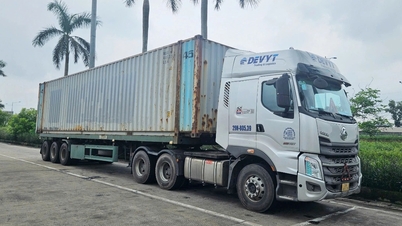
















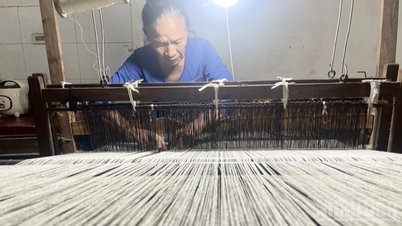



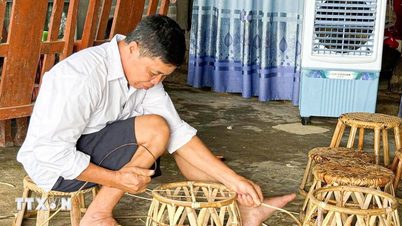
















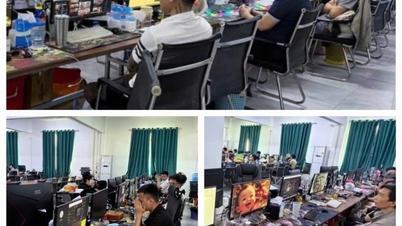





















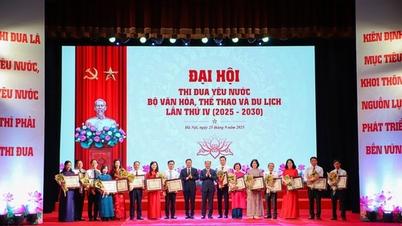










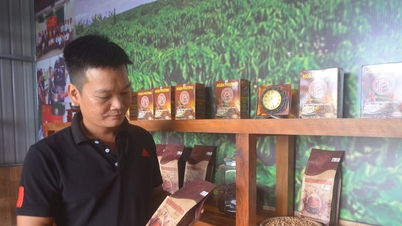

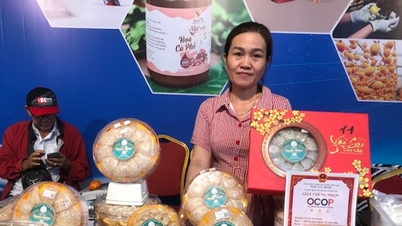

















Comment (0)